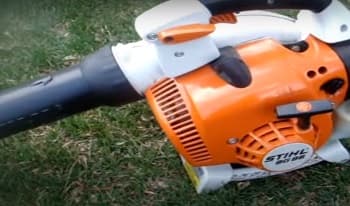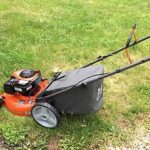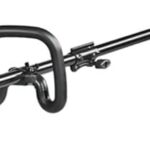As an Amazon Associate, this site earns commissions from qualifying purchases. For more information click here.
You have been using your leaf blower for a while now and everything is fine. Suddenly the engine stops. You try starter fluid and nothing happens. Is the blower broken? Starter fluids are supposed to jump start engines, so if it does not work, there must be a serious problem right? No worries as this post shows you how to solve this predicament.
If your leaf blower won’t run with starter fluid, it is probably due to a broken spark plug or cracked fuel line. Add fresh fuel and if it does not work, gas is not getting into the carburetor. Clean or replace the carburetor and that should solve the problem.
This issue is related to the engine so there are a lot of other possible causes. We will go through the most likely reasons and how to fix them step by step.
Crank the Blower
Turn the leaf blower off and remove the spark plug. Set the choke to off and pull the starter cord 6-8 times. In many cases this will be enough to start the engine.
If the blower refuses to work, clean the cylinders with an air blower. Replace the spark plug with a new one or clean it well. Keep the choke setting off and crank it again. Try it with the switch on. You can also try switching it on and off while cranking.

Related. Why your leaf blower has spark and fuel but won’t start
Dirty or Damaged Carburetor
Carburetors can be tricky and cause all kinds of issues. You can do the following test to see if it is the culprit.
Turn the blower off and remove the spark plug. Now crank the blower and see what happens. Ensure the plug wiring is grounded before attempting to crank. If the engine refuses to run, fuel is not getting to the engine.
Most likely there is an issue with the carburetor and it needs cleaning or replacement. The float could also be stuck in the closed position and needs to be fixed.
It is also possible there is leftover gas in the carburetor. If the carburetor is not broken, cleaning it with the SQ Carburetor Cleaner should be enough to fix the engine.
Engine Flooded
Is there fuel coming out of the exhaust? If yes, the engine is flooded. There is too much fuel and not enough air present. There are two ways to fix this.
The first is to let the engine idle. If the flooding is not too bad, the engine will burn the excess fuel off. After a few minutes the blower will run again. If that does not help, you have to replace the spark plugs or clean them.
If there is no fuel in the exhaust, you probably have air in the fuel line. Inspect the line and have it replaced if there is damage.
There are many causes for engine flooding, but the solution is the same. Run the blower and set it to full throttle if possible. Allow the engine to burn the oil and that should fix the problem.
Replace the Spark Plugs
A lot of leaf blower problems stem from damaged spark plugs. Fortunately it is easy to replace them. Turn the blower off and check the plug. If there is damage, replace it with a new one. Bring the plug to the hardware store so you can show them what type of plug you need.
Put the spark plug in and try again. If that does not work, remove the plug and pour new starter fluid in the plug hole. The STA-BIL works well in these cases.
Put the spark plug back on and turn the engine on.
If you are not sure whether to replace or clean the spark plug, here is a simple rule. If the plug is completely covered in oil, it is better to get a replacement. Cleaning will take too much time and the plug may have been already damaged.
Replace the Fuel
If the fuel is more than 30 days old, it needs to be replaced. It does not matter if the blower is a 2-sstrok or 4-stroke. The fuel has to be fresh for the engine to work.
2-stroke leaf blowers need a mixture of gas and oil. The ratio is usually 40: 1 but you can get additional information on your owner’s manual. 4-stroke engines do not mix gas and oil. Pour them in their respective compartments.
Before pouring, clean the tank or tanks first. If you left fuel there for months, it might have turned into a viscous fluid. Clean the tank and every part of the engine that got covered by oil. When it is thoroughly cleaned, add new fuel.
Wrong Fuel Mix Ratio
2-stroke leaf blowers need a 40:1 fuel ratio, which is 3.2 ounces of oil for one gallon of gas. If the ratio is off even by just a little, the blower will not function. Ideally you should use up all the fuel before 30 days are up. If not, the gas dissipates over time and the oil starts to block everything in the engine.
With a 4-stroke engine, do not mix the fuel. If you do this can lad to issues and the blower might stop running. You should also check the manual for what type of fuel to use. Usually unladed gas is fine with 87 octane rating and no more than 10% ethanol.
Dirty Air Filter
Leaf blowers will not run with a clogged air filter. As you might have guessed, the filter is used to block debris so only clean air gets into the combustion chamber and mix with the fuel.
Clean or replace leaf blower air filter after every 20 hours of use. The following steps show you how it is done.
- Turn the leaf blower off. If you are using an electric blower, unplug it.
- Take the air filter cover off. The location may vary from one leaf blower to another, so refer to your owner’s manual. With some leaf blowers you just lift the latch. Others might quirk you to remove some screws or bolts.
- Remove the air filter. Usually these are made of sponge or a similar material. Check for signs of tear. If there is none and it is just dirty, cleaning will suffice.
- Prepare a mix of soapy water and put the filter in it. Squeeze the filter lightly to remove the dirt. Be careful not to tear it.
- When cleaned, squeeze the excess water out. Rinse and let it dry.
- Place the air filter back into the leaf blower and put the cover back on.
Use Seafoam Gas Treatment
Seafoam is an additive for gas and oil. It is used to lubricate engines and can also fix leaf blowers that will not start.
If you are getting sparks and the hose is still working, you can try this method.
- Pour 1 oz. of Seafoam in the fuel tank. Add 1 oz. of gas.
- Pump the primer bulb 8 to 10 times and remove the spark plug.
- Set the choke position to on, and pull the cord 12 times. If the machine does not start, leave it there overnight.
- The next day, remove the Seafoam and gas in the fuel compartment. Pour fresh fuel and pump the primer bulb 8 to 10 times.
- Put the spark plug back on and set the choke to the on position. Crank the engine thrice. If that does not work, turn the choke off and try again.
- Most of the time that is going to work. If the engine still refuses to work, the carburetor is damaged or has to be cleaned up.
Should You Use Starter Fluid at All?
Use starter fluid only as a last resort. It can be bad for small engines and might cause damage if you pour too much. You can use a small amount to test the blower, to find out why it is not running.
In general though a starter fluid should not be needed. If you are having problems getting a 2-stroke or 4-stroke blower to run, it is probably due to the fuel, carburetor or spark plug. Cleaning or replacing any of those will fix the issue.

I love the outdoors and all the tools for maintaining gardens, yards and lawns. The only thing I am more passionate about is sharing what I know about garden and outdoor equipment.


